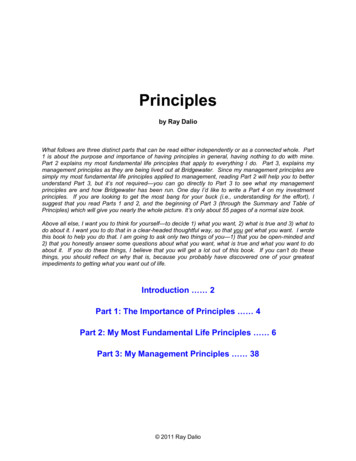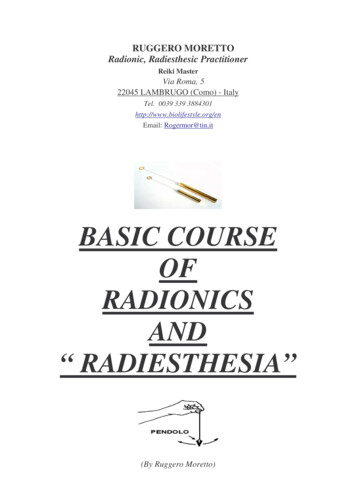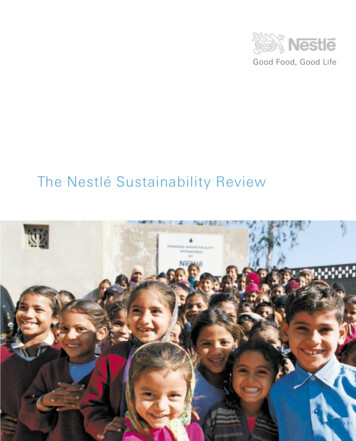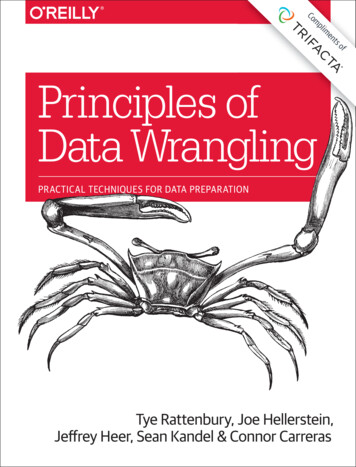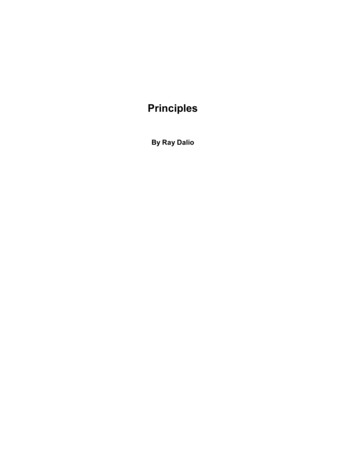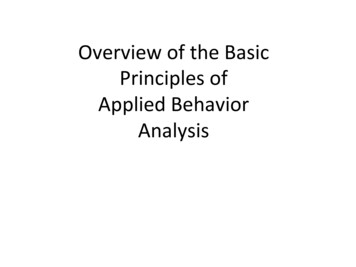
Transcription
Overview of the BasicPrinciples ofApplied BehaviorAnalysis
Key Principles of ABA(Kerr & Nelson, 2010)In managing classroom behavior and designing interven3ons, it iscri3cal that teachers understand these principles: Consequences control behavior Reinforcement strengthens or maintains behavior– PosiGve Reinforcement– NegaGve Reinforcement Consequences that have maintained behavior can also weakenor decrease behavior by being withheld– ExGncGon Punishment also weakens behaviorEstablish con-ngencies by consistently and immediately followingtarget behaviors with consequencesUse modeling to strengthen, weaken, or maintain behavior
SystemaGc Procedures for Influencing Behavior(Consequences) Increase– PosiGveReinforcement– NegaGveReinforcement Decrease– ExGncGon– Punishment
PosiGve ReinforcementEssenGal to improving behaviorPosiGve Reinforcement is the“Con,ngent presenta,on of a sGmulus, following aresponse, that increases the probability or rate ofthe response.”(Alberto & Troutman, 2009 p. 217)
PosiGve Reinforcers Types of reinforcers– Primary: innately moGvaGng, natural, unlearned (e.g., food,liquids)– Secondary: condiGoned & learned (e.g., tokens) SelecGng reinforcers– Can not say for sure something is a reinforcer unGl the impacton the behavior can be determined– Consider student age, reinforcement history, development, &interest– Reinforcer sampling Ask studentRank order by studentDistribute reinforcer menuConduct object sampling(Alberto & Troutman, 2009)Observe duraGon of gaze, engagement
Types of ReinforcersPrimary ReinforcersSecondary angeablePraiseSmileThumbs Point
ConsideraGons for using Reinforcers Reinforcement must be conGngent (if . then ). Work to replace primary reinforcers with secondaryreinforces. As much as possible, let student select reinforcers Assign reinforcer to specific tasks or behaviors (not onefor the enGre day). Watch for signs of saGaGon and change reinforcers asneeded. Decrease the size of edible reinforcers to preventsaGaGon. UGlize schedules of reinforcement – do not provide areinforcer for each correct response or instance ofbehaviors.(Alberto & Troutman, 2009)
From: professional development.gcsnc.com/./Elementary%20‐ %20Secondary%20Reinforcer%20Menu%20With%20Key.doc
From: professional development.gcsnc.com/./Elementary%20- %20Secondary%20Reinforcer%20Menu%20With%20Key.doc
Visual MenusThe image cannot be displayed. Your computer may not have enough memory to open the image, or the image may have been corrupted. Restart your computer, and then open the file again. If the red x stillappears, you may have to delete the image and then insert it again.
Schedules of Reinforcement Timing paberns for delivery of reinforcement When teaching and establishing a new behavior,reinforce each instance (i.e., conGnuous reinforcement) Once a behavior is established, make reinforcement lesspredictable– Move from high rates of reinforcement to variable rates– Be careful not to reduce the reinforcement too quickly Intermibent reinforcement refers to reinforcement thatis not given for each instance of a response(Alberto & Troutman, 2009; Kerr & Nelson, 2010)
Schedules of Reinforcement
Schedules of Reinforcement Con,nuous reinforcement: every instance of abehavior is reinforced IntermiAent reinforcement: some ‐ not all responsesare reinforced– RaGo schedules: Reinforcement is based on the number ofbehaviors required– Interval schedules: Reinforcement is based on the passage ofGme– DuraGon schedules: Reinforcement is based on theconGnued performance of a response for a period of Gme– Fixed schedules: The requirements for reinforcement arealways the same– Variable schedules: The requirements for reinforcementchange randomly(Alberto & Troutman, 2009)
NegaGve Reinforcement“The conGngent removal of an aversive sGmulus immediatelyfollowing a response that increased the future rate and/orprobability of the response.”(Alberto & Troutman, 2009, p. 254)Examples:Steve will put on seat belt to stop buzzer.Luke will clean up his room to stop escape parent nagging.Mark completes his work to avoid having to stay in theclassroom during PE.The term “reinforcement” means a behavior will increase– Both posiGve and negaGve reinforcement are associated withincreases in behavior(Alberto & Troutman, 2009)
What things are aversiveto students in the classroom? Certain academic tasksCertain peersUnclear teachers direcGonsNagging or negaGve teachersStudent may misbehave to “escape” these aversives-muli. If allowed to “escape” and the teacherobserves an increase in disrup-ve behavior, thestudentʼs disrup-ve behaviors have been nega-velyreinforced (i.e., the aversive s-muli has beenremoved).(Alberto & Troutman, 2009)
NegaGve ReinforcementBe careful. Consider this scenario Teacher gives student an assignment (theassignment is aversive to the student)––––Student is disrupGveTeacher removes work (i.e., removes aversive sGmulus)Teacher has negaGvely reinforced the disrupGve behaviorThe next Gme the teacher presents the work, the cycle isrepeated because the student has learned that disrupGonworks in gehng the teacher to remove the assignment. Teachers need to understand how their behaviorreinforces and teaches the wrong student behaviors(Alberto & Troutman, 2009)
EffecGve Use of NegaGveReinforcement If students are moGvated byescape from or avoidance ofaversive sGmuli, teachstudents a more appropriateway to “escape” or “avoid”– For example: Teachstudents to request abreak or ask for help
ExGncGon“Withholding reinforcement forpreviously reinforced behavior toREDUCE the occurrence of thebehavior”(Alberto & Troutman, 2009, p. 424)Most ojen used to decrease problembehaviors that have beenreinforced /maintained by teacherabenGon
ConsideraGons for ExGncGon ExGncGon is not a fast way to decrease a behavior– Targeted behavior will typically conGnue before it decreases (i.e., resistanceto exGncGon)– Targeted behavior may increase or get worse before it decreases (i.e.,exGncGon burst) Some students may respond to exGncGon with aggression (i.e.,exGncGon‐induced aggression) ExGnguished behavior may temporarily reappear at some point (i.e.,spontaneous recovery) Peers may also be reinforcing a target behavior ExGnguished behaviors do not generalize to other sehngs well(Alberto & Troutman, 2009)
EffecGve Use of ExGncGon Use exGncGon in conjuncGon with thereinforcement of appropriate behaviors– Remember that an “absence” of behavior is not the goal of classroommanagement. Instead, the goal is for students to learn and use sociallyappropriate behavior. Once a behavior has been put on exGncGon, do notreinforce – this will only make it harder to eventuallyexGnguish To control for peer abenGon, peers can bereinforced for withholding abenGon for problembehavior To increase generalizaGon, adults in mulGple sehngsmust also use exGncGon
Punishment “The conGngent presentaGon of asGmulus immediately following aresponse, which decreases thefuture rate or probability of theresponse” (Alberto & Troutman,2009, p. 426). Example: Time‐out from free play(preferred acGvity) ajer hihng;hihng decreases To be defined as a “punisher”,there must be a decrease in thebehavior(Alberto & Troutman, 2009)
ConsideraGons for PunishmentBenefits of Punishment Stops behavior InstrucGve to peersDisadvantages of Punishment Punishment shouldbe used ona limited basis andin conjunction withproceduresto increase sociallyacceptable behaviorOveruseNegaGve self‐esteemWithdrawal or escapeIncrease in aggression and anGsocial behaviorPeer reacGonsDamages student/teacher relaGonshipsWhat is the student learning?
Key Behavioral tExtinctionBehavior principles can only be identifiedby their impact on behavior
ReferencesAlberto, P. A., & Troutman, A. C. (2009). Applied behavior analysisfor teachers (8th ed.). Upper Saddle River, NJ: Merrill.Kerr, M. M., & Nelson, C. M. (2010). Strategies for addressingbehavior problems in the classroom (6th ed.). Boston, MA:Pearson.
Applied Behavior Analysis Key Principles of ABA (Kerr & Nelson, 2010) In managing classroom behavior and designing intervenons, it




